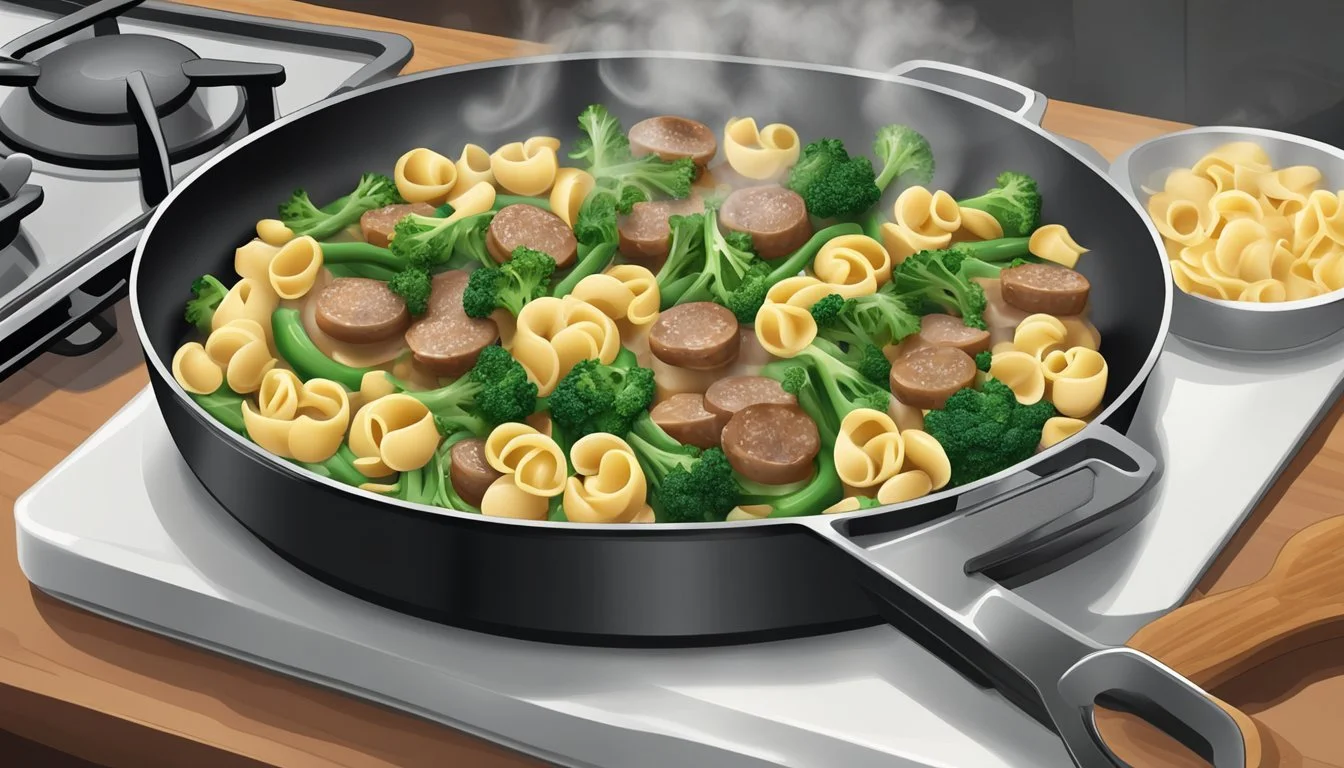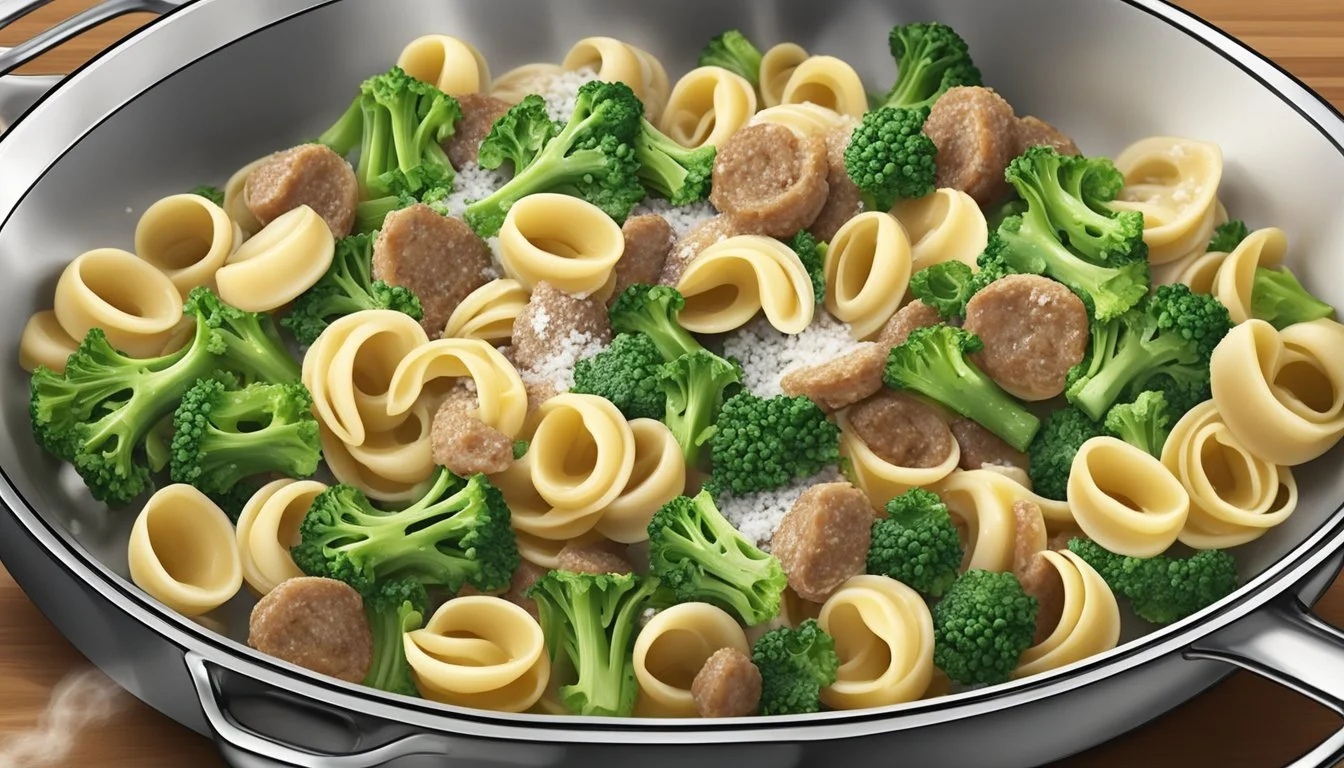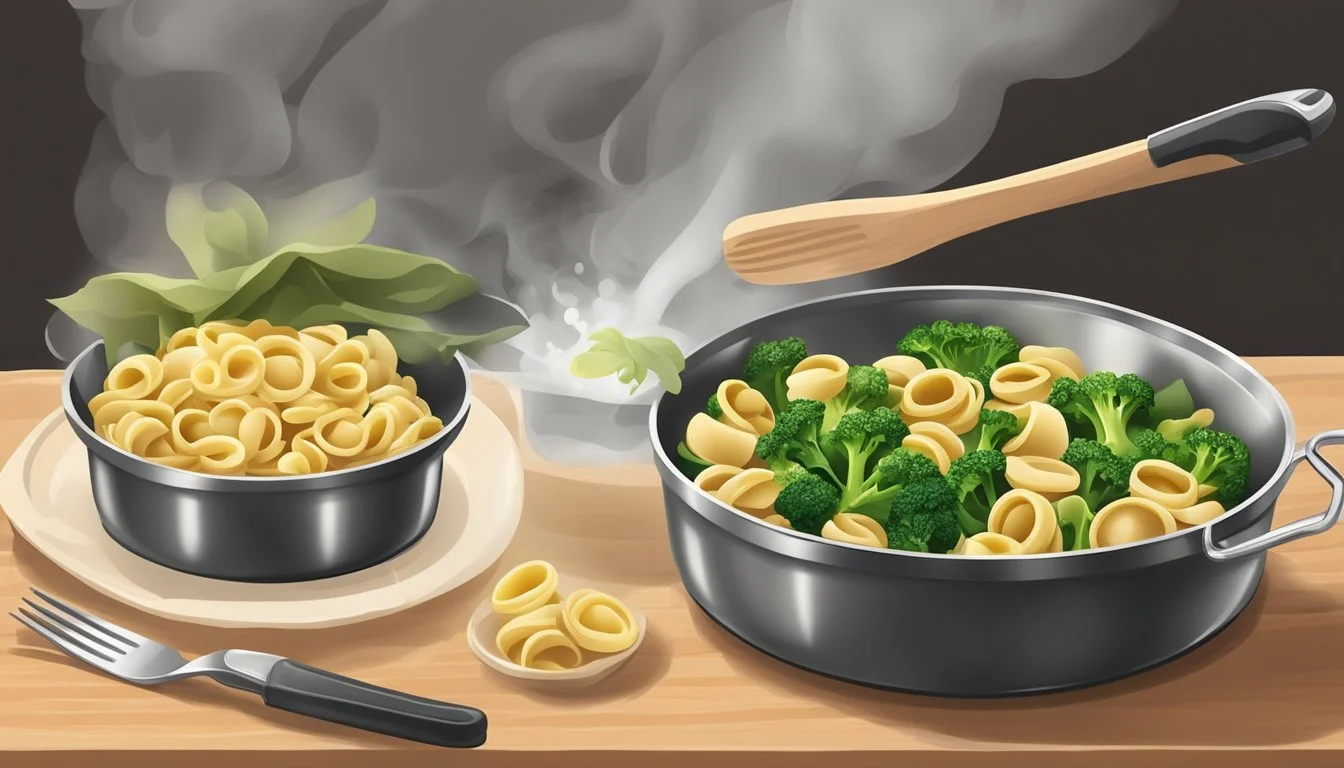Best Way to Reheat Orecchiette with Sausage and Broccoli Rabe
Ensuring Perfect Texture Every Time
Orecchiette with sausage and broccoli rabe is a classic Italian dish that marries the slight bitterness of broccoli rabe with the rich flavors of sausage—two tastes that complement the ear-shaped pasta (What wine goes well with pasta?) exceptionally. When reheating this dish, the goal is to maintain the al dente texture of the orecchiette and the tenderness of the sausage. Achieving this requires a method that respects the delicacies of the pasta's cooking time and the sausage's savory qualities.
One must thoughtfully approach reheating to avoid overcooking the pasta or drying out the sausage. Since orecchiette is prone to sticking together and sausage can lose its tenderness if reheated improperly, gentle methods are preferred to restore the dish to its near-original state. The process should ensure that each element—pasta, sausage, and broccoli rabe—is warmed through while preserving the integrity and flavor balance of the recipe.
Reheating such a dish calls for a low and slow approach, utilizing either a stovetop or an oven to encourage even warmth without introducing a stark temperature change that could impact texture. This maintains the orecchiette's bite and the comfort that comes from a dish crafted with Italian culinary traditions in mind. Employing the right reheating technique allows the full flavor profile of the orecchiette with sausage and broccoli rabe to shine through as if freshly made.
Understanding Orecchiette Pasta
Orecchiette pasta, originating from the Puglia region of Italy, is renowned for its distinct shape and texture, which are key to its culinary appeal. It's crucial to appreciate orecchiette for its unique properties, especially when considering reheating to maintain al dente texture.
Origins and Characteristics
Orecchiette, meaning "little ears" in Italian, hails from the Puglia region, a place celebrated for its diverse pasta shapes and rich history of Italian cooking. Characterized by a small, concave shape resembling a tiny ear, this pasta form is designed to cradle sauces and small food pieces. Traditionally hand-made from durum wheat, orecchiette has a firm, chewy texture when cooked to al dente, which is considered the ideal texture in Italian cuisine. This pasta's ability to hold on to robust flavors is due to its slightly rough surface, which is achieved through the dragging of the dough over a wooden board with a non-cutting tool like a knife or a spatula.
Region: Puglia, Italy
Translation: Little ears
Texture: Firm and chewy (al dente)
Preparation: Traditionally hand-made
Ideal Pairings
Orecchiette pasta pairs exceptionally well with ingredients that complement its texture and shape. A classic dish, Orecchiette con le Cime di Rapa, combines the pasta with broccoli rabe (cime di rapa) and sausage (salsiccia), creating a balance of flavors and textures. The slightly bitter taste of broccoli rabe contrasts with the savory, tender quality of the sausage, while the orecchiette's cup-like shape expertly captures both the vegetable and the meat. This harmony of components makes orecchiette with sausage and broccoli rabe a beloved dish throughout and beyond Italy.
Classic Dish: Orecchiette con le Cime di Rapa
Common Pairings: Broccoli rabe, sausage
Flavor Balance: Bitterness of broccoli rabe with the savory sausage
Texture: Orecchiette's ability to capture elements within its shape
By understanding the origins and ideal pairings of orecchiette pasta, one can better appreciate the nuances of preparing and reheating the dish to enhance its authentic Italian flavors.
Preparation Basics of Italian Sausage
The key to a perfect dish of Orecchiette with Sausage and Broccoli Rabe rests on the choice and preparation of the Italian sausage used. Selecting the right sausage impacts the flavor, while proper cooking ensures tenderness.
Selection of Sausage
When selecting Italian sausage, one has two primary choices: pork sausage or its poultry counterparts, chicken or turkey (What wine goes well with turkey?) sausage. Pork sausage traditionally has a robust flavor profile, often enhanced with fennel and a mix of spices. For a leaner option, chicken or turkey sausage can be considered, although these may have a milder taste. For those desiring a spicier kick, a spicy Italian sausage variant, boosted with red pepper flakes, is ideal.
Pork Sausage: Rich flavor, commonly spiced with fennel.
Chicken/Turkey Sausage: Leaner, milder flavor, suitable for lighter recipes.
Spicy Italian Sausage: For adding heat to the dish.
Cooking Techniques to Retain Tenderness
Two favored techniques emerge when cooking Italian sausage to retain its tenderness: simmering and sautéing. Simmering involves cooking the sausage slowly in a little liquid on low heat, allowing the meat to cook evenly without becoming tough. Sautéing, on the other hand, requires one to cook the sausage over medium-high heat with some olive oil, ensuring that it’s browned but still succulent.
Simmer: Place the sausage in a pan with a small amount of water or broth. Cook on low heat until it's almost cooked through, which helps to keep it tender.
Sauté: Heat olive oil in a pan over medium-high heat. Add the sausage and cook until browned, making sure to turn regularly for an even cook.
When sautéing, the sausage should not be overcooked as this can cause it to become dry. If the recipe requires further cooking with other ingredients, the sausage should be slightly undercooked during the sauté phase.
Optimal Cooking Methods for Broccoli Rabe
Preparing broccoli rabe properly is essential for achieving a balance between its naturally bitter flavor and the desired tenderness. The following subsections describe two crucial cooking techniques.
The Importance of Blanching
Blanching broccoli rabe is a crucial first step before sautéing to ensure that the bitter greens lose some of their harshness while retaining a vibrant color and crisp texture. To blanch, bring a pot of water to a boil, add a liberal amount of salt, and immerse the broccoli rabe for about one to two minutes. Then, remove it quickly and submerge it in ice water. This stops the cooking process and sets the color, maintaining the bright green of the leaves and the florets.
Sautéing with Garlic and Olive Oil
After blanching, broccoli rabe is ready to be sautéed. Heat extra virgin olive oil in a pan over medium heat, then add finely chopped garlic, allowing it to infuse the oil with flavor without burning. Introduce the blanched broccoli rabe to the pan and sauté until it is tender but still firm. This technique helps to further mellow the bitterness and infuses the broccoli rabe with a rich, garlic flavor while keeping the florets and stems tender and palatable.
Crafting the Sauce
The quality of the sauce is paramount in reheating orecchiette with sausage and broccoli rabe, to ensure the flavor is robust and complements the al dente pasta and tender sausage.
Ingredients and Flavor Enhancers
White Wine: Adds acidity and deglazes the pan, capturing the fond for a more complex sauce.
Garlic: A key aromatic that infuses the sauce with pungent warmth.
Anchovy (optional): Delivers umami depth to the dish when finely chopped and melted into the sauce.
Red Pepper Flakes: Introduces a subtle heat to the mix.
Ingredient Quantity Notes White wine 1/2 cup Preferably dry Garlic 3 cloves Finely minced Anchovy fillets 2 Finely chopped (optional) Crushed Red Pepper 1 tsp Adjust according to heat preference
In addition to these, grated Parmigiano Reggiano or Pecorino Romano cheese should be on hand to finish the sauce, enhancing its creaminess and adding a sharp, salty note.
Combining Elements over Heat
One begins by sautéeing the minced garlic in olive oil over medium heat until it turns golden – this should be watched closely to avoid burning. At this juncture, if using anchovy, it should be added to melt into the garlicky oil. A pour of white wine follows, which should be allowed to simmer to reduce slightly; this process helps concentrate the wine's flavor.
It is crucial to simmer and not to rush this stage, as proper simmering allows flavors to meld and develop. Adjust the heat accordingly to maintain a gentle bubble within the pan. Once the alcohol from the wine has evaporated and the sauce thickens, a pinch or more of red pepper flakes can be stirred in to introduce heat. Lastly, the cheese is added off the heat to avoid clumping, ensuring a smooth, velvety sauce that is ready to coat the orecchiette, sausage, and broccoli rabe when reheated.
Reheating Techniques
When reheating Italian pasta dishes like Orecchiette with Sausage and Broccoli Rabe, maintaining the texture of the pasta and tenderness of the sausage is paramount. The following techniques ensure leftover pasta is reheated to al dente perfection while the sausage remains tender.
Skillet Reheating for Even Warmth
Using a skillet allows for even distribution of heat, which is essential to keep the orecchiette al dente and the sausage juicy. One should:
Heat a skillet over medium flame.
Add leftover pasta along with a splash of pasta water to prevent sticking.
Stir gently until the pasta is warmed through and the water has evaporated.
Moisture Control with Pasta Water
Adding pasta water is a chef's secret for retaining moisture in pasta dishes:
Before Draining: Reserve a cup of pasta water from the orecchiette when initially cooking.
While Reheating: Splash the pasta water over the orecchiette during reheating to maintain its moisture without becoming soggy.
Oven Heating for Larger Batches
For reheating larger quantities, the oven provides a consistent and gentle heat:
Preheat the oven to 350°F (175°C).
Spread the pasta and sausage evenly in an oven-safe dish.
Cover with foil to prevent drying, and heat for about 10-15 minutes until hot.
Serving and Presentation
In presenting Orecchiette with Sausage and Broccoli Rabe, ensuring the pasta maintains its al dente texture and the sausage remains tender is paramount. These nuances elevate the dish and appeal to discerning palates.
Adding the Final Touches
Before serving, one can enhance the flavor and appearance of the dish with a few considered additions. Drizzling a bit of high-quality olive oil over the pasta can introduce a fresh, fruity essence to the profile. A moderate sprinkling of grated Parmigiano Reggiano adds both a nutty flavor and an appealing visual contrast. For a subtle fresh zing, a light squeeze of lemon juice or a scattering of finely chopped parsley can brighten the dish.
Olive Oil: Extra virgin, drizzled
Cheese: Parmigiano Reggiano, freshly grated
Acid: Lemon juice, freshly squeezed
Herbs: Parsley, finely chopped
Determining Appropriate Portions
The right portion size for this robust recipe hinges on whether it is served as a main course or a side. If it's the main attraction, a serving of approximately 1 to 1.5 cups of orecchiette pasta per person is sufficient. As a side dish, halve this amount to complement the main entrée without overshadowing it.
Context Orecchiette Pasta Portion Main Course 1 to 1.5 cups Side Dish 0.5 to 0.75 cups
Present the dish immediately after adding the final touches to preserve the taste and texture, ensuring a thoroughly enjoyable dining experience.
Alternate Variations and Substitutions
When customizing your orecchiette with sausage and broccoli rabe, substitutions can keep the dish exciting and cater to dietary preferences without compromising the essence of this classic pasta dish.
Meat and Vegetarian Options
For those who prefer different types of meat or are looking for a vegetarian twist, several substitutes can be considered. Italian sausage is traditionally used for its robust flavor, but one can opt for chicken sausage or turkey sausage for a lighter, leaner alternative that still maintains tenderness. To accommodate a vegetarian diet, one might replace the meat entirely with a hearty vegetable such as broccolini, spinach, or even cubed turnip to mimic the satisfying bite sausage provides.
Meat Substitutes:
Chicken Sausage - Less fat, retains juiciness
Turkey Sausage - Lean, mimics the texture of Italian sausage
Vegetarian Substitutes:
Broccolini - Similar to broccoli rabe, slightly sweeter
Spinach - Wilt down like sausage, adds color
Turnip - Roasted for a meaty texture, absorbs flavors
Pasta Alternatives for Different Textures
Although orecchiette is the pasta of choice for this recipe due to its ability to hold onto sauce and other ingredients, various pasta shapes can be used to alter the texture and presentation of the dish. Ziti offers a tube-like structure that encapsulates the flavors similarly to orecchiette but with a different mouthfeel. Fusilli, with its twists and turns, also provides an interesting texture while catching small bits of sausage and broccoli rabe, making every bite flavorful.
Pasta Textural Variations:
Ziti - Tubular, good sauce carrier, offers a distinct bite
Fusilli - Spiral-shaped, traps ingredients within its curls
Storage and Make-Ahead Tips
When it comes to preserving the texture and flavor of orecchiette with sausage and broccoli rabe, proper storage techniques are critical. By refrigerating or freezing leftovers appropriately, one can enjoy this dish with the same al dente pasta and tender sausage as when it was first made.
Proper Refrigeration Techniques
The key to refrigerating orecchiette with sausage and broccoli rabe is to cool the dish rapidly to prevent bacterial growth. Leftovers should be placed in a shallow airtight container and refrigerated within two hours of cooking. Utilize the following steps for optimal refrigeration:
Cool Down: Spread the leftovers out on a large, shallow dish to allow for faster cooling.
Airtight Containers: Transfer the cooled pasta into an airtight container to preserve moisture and flavor.
Shallow Layers: If storing a large quantity, use multiple containers to store the pasta in thin layers.
Labeling: Mark the container with the date to keep track of how long it's been stored.
Leftovers can be safely refrigerated for 3 to 5 days. When ready to reheat, gently warm the pasta over low heat, adding a bit of water or broth to keep everything moist.
Freezing for Long-Term Storage
For longer storage, freezing orecchiette with sausage and broccoli rabe is an effective method. It retains the quality for up to 2 months. Follow these steps to ensure proper freezing:
Cool Completely: Before freezing, ensure the dish is completely cooled to room temperature to prevent ice crystals from forming.
Portion Sizes: Divide the pasta into serving-sized portions for convenient thawing.
Freezer-Safe Containers: Use freezer-safe bags or containers to protect the food from freezer burn.
Label and Freeze: Clearly label each container with the date and place them in the coldest part of the freezer.
To serve, thaw the pasta in the refrigerator overnight, then reheat it on the stove or in the microwave, adding a splash of water or broth as needed.
Health and Dietary Considerations
When approaching the health and dietary considerations for reheating Orecchiette with Sausage and Broccoli Rabe, it's important to recognize the balance between preserving the dish’s traditional flavors and adhering to personal nutritional needs. Substitutions and adjustments can help tailor the meal to various dietary restrictions while maintaining its essence.
Adapting the Dish for Dietary Restrictions
Gluten Intolerance/Celiac Disease:
Pasta: Use gluten-free orecchiette pasta to accommodate this dietary need.
Sausage: Verify that the selected sausage is gluten-free, as some sausage products may contain fillers with gluten.
Reduced-Fat Diet:
Sausages: Opt for chicken or turkey sausage instead of traditional Italian sausage to decrease the fat content without substantially altering the taste.
Cooking Oil: Substitute regular olive oil with a spray or a smaller amount to reduce fat without losing the savory flavor profile.
Lactose Intolerance:
Many orecchiette dishes include cheese; use lactose-free cheese or nutritional yeast as a replacement.
Balancing the Meal's Nutritional Profile
Macronutrients: Focus on the proportions of protein, carbohydrates, and fats to ensure a well-rounded meal.
Protein: Maintain tenderness in the sausage during reheating, whether it's pork, chicken, or turkey, to support muscle repair and growth.
Carbohydrates: Reheat the pasta al dente to avoid a mushy texture and to manage blood sugar levels better.
Micronutrients:
Vegetables: Incorporate broccoli rabe, which is rich in vitamins A, C, and K, to boost the nutritional value.
Olive Oil: Use olive oil in moderation for its heart-healthy fats but be cautious of the calorie density.
Sodium:
Salt: Moderate the salt content if the dish is originally high in sodium or if dietary restrictions require low-sodium alternatives.
By modifying components such as the type of sausage or pasta and adjusting the cooking techniques, one can reheat this classic Italian dish in a way that is both health-conscious and satisfying.




